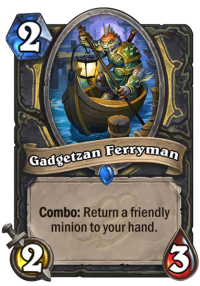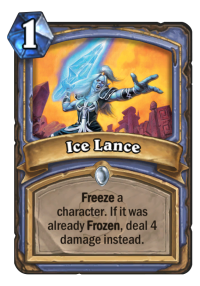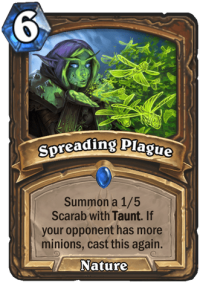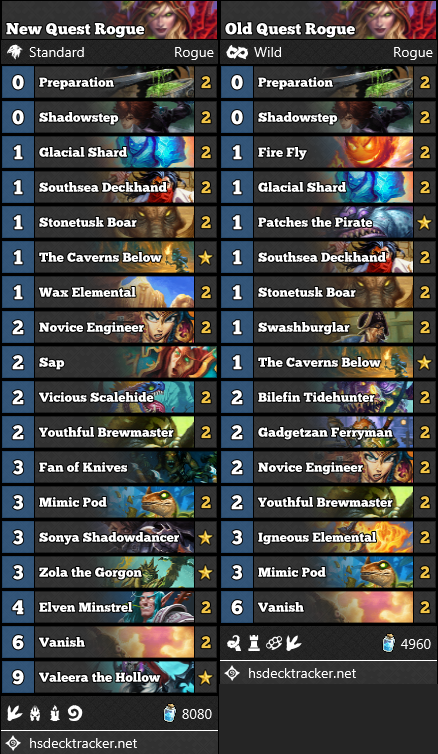This isn’t the first time that The Caverns Below terrorized a certain portion of the playerbase: Quest Rogue has already seen quite extensive play back in the day, so much so that it has eventually been nerfed to its current state, despite, as the developers repeatedly stated, not having particularly high win-rates. Do the same arguments apply in today’s meta, where many a control player froths at the mouth at the prospect of insta-conceding against this particular archetype?

There’s no question that Quest Rogue can be incredibly frustrating to play against. It’s also a problematic gameplay experience when it’s almost correct to go to the bottom right corner the moment your opponent throws out that signature one-cost spell that’s always in your starting hand. (For what it’s worth, it still isn’t exactly optimal, but I can certainly understand the benefits of trying to protect your sanity in exchange for a minuscule amount of percentage points.) Still, the complaints about the deck are nothing new in nature, and not just because of the fact that it has already been adjusted once – basically all combo decks get this sort of treatment by a vocal minority of the community, members whose outcry can certainly be loud enough to get Team 5 to act, but basically for all the wrong reasons.
Balancing around how a deck feels is fairly dangerous: all archetypes will conjure up negative feelings if they are left unchecked. Aggro is brainless SMOrc that never even trades; tempo decks are “Curvestone”; combo decks are “fun and interactive” solitaire experiences from the other side; and control decks just constrict you and won’t let you play by killing everything you put on the board and slowly grinding you down. All of these archetypes were decried as brain dead at some point throughout the history of Hearthstone, meaning you shouldn’t value these particular complaints highly.

To ask whether or not Quest Rogue needs another nerf is to ask whether we want decks like this in Hearthstone: the description of a skill-intensive, solitaire-like deck that’s bad against aggro but has inevitability basically fits Freeze Mage to a T as well, with the notable exception of its Control Warrior matchup – again, an incredibly one-sided battle, but that was more of a curiosity than a meta-wide balance issue. Perhaps the main difference between the two is the fact that most of the old-school combo decks could be forced to waste some of their damage potential in the early game in order to survive, making the gameplay experience a bit more back-and-forth than the fight against a deck that is literally based around bouncing its minions between the board and the player’s hand. If we accept that the discussion has to revolve around specifics rather than mere archetypal concerns, the best way to look at the concerns with Quest Rogue is to look at the previous version of the deck that eventually was deemed too powerful. Does this version live up to the original?
It’s clear on first glance that the “prototype” is way more explosive than the current iteration, having two extra bouncers for only four quest objectives while also making use of the original Patches the Pirate whose charrrrrrrge meant that it was even easier to finish off a slower opponent once you received the Crystal Core. This version has essentially become unplayable after the nerf for two reasons: it lacked the survivability against aggressive decks and, crucially, it didn’t actually have a functionally endless stream of minions available when the game went long.
Much of the frustration of control players stems from the fact that a combination of the Valeera the Hollow and Zola the Gorgon essentially guarantees an infinite stream of cheap 5/5s in a way that even a Jade Druid would be jealous of, meaning it has become completely impossible to outlast Quest Rogue, which was a realistic possibility against the pre-nerf version with chunky Taunts. Also, the unique interaction between Elven Minstrel. Also, the inclusion of Vicious Scalehide essentially means that completing the quest qualifies as a win condition against aggro as well under most circumstances.
The other major factor is the metagame in which the deck needs to operate. The Un’goro set was out for two and a half months by the time the decision has been made about the nerf, meaning it’s still fairly reasonable to expect developments in the scene today. The current metagame is generally classified as a rock-paper-scissors environment with hard-counters all over the place and mid-range archetypes completely extinct from the game: the situation was nowhere this polarized back in those days. Aggressive decks were much more effective at keeping Quest Rogue at bay back then – the Pirate package made those more powerful than today’s alternatives despite the fact that we’re at a similar point in the Standard year cycle – while some of the slower archetypes could also resist the onslaught, like Freeze Mage (RIP Ice Block) that had a brief resurgence at the time.
Crucially, Quest Rogue was the most effective in high ranks back then, while it is currently getting seriously squeezed out on the top levels by a major metagame adjustment that includes the rapid rise of Tempo Mage and the fall of decks like Taunt Druid while still performing fairly well in the lower ranks. It’s always going to be the go-to counter to whichever control deck is the flavor of the day, but we’ve got the technology to squeeze it out when it goes overboard. Still, its polarizing effect on tournament line-ups cannot be understated, even if that likely isn’t a major factor when it comes to nerf-related decisions. It may be true that the deck doesn’t prey on the metagame, but this polarized nature of its match-ups still warrants further discussion.
As per the nerf announcement, “Since the release of Journey to Un’Goro, Hearthstone has enjoyed a wider variety of competitively viable classes and decks than ever before. We’ve been monitoring overall gameplay, and we’ve decided that—even though everything is varied and many decks are viable—a change to The Caverns Below is still warranted.

The Caverns Below is uniquely powerful versus several slower, control-oriented decks and played often enough that it’s pushing those decks out of play. This change should help expand the deck options available to players both now and after the release of the next expansion.” Again, the usual lack of specifics plaguing the developers’ communication bites us in the rear here. The current environment certainly fits this particular description, but one would like to believe that there’s more to their design decisions than such a two-paragraph explanation.
One more thing about Team 5’s design decisions: for preserving previous meta decks and gameplay experiences, the current systems seems like the worst of both worlds. Problematic decks sour the Standard ladder experience for way too long, and when the eventual nerf arrives, I can never play the deck again in any of the game modes, unless someone wins a World Championship with them and they show up in a special brawl. It’s safe to say that whatever the eventual decision regarding Quest Rogue is, it will be mostly because of its Standard implications – after all, it took almost two years to roll out nerfs that specifically had the eternal format in mind.

In general, I’d argue that having a control-killer is not a problem in and of itself as long as it really struggles against other archetypes and if we’re also able to counter aggro or combo with such efficiency. (Let’s blissfully ignore the fact that the latter has basically never been true in the history of Hearthstone.) Looking at it this way, most of our current problems stem from the fact that the current iteration of Quest Rogue is much more effective against (minion-based) aggressive decks as its predecessor was. The whole situation reminds me of the time when Jade Druid got completely out of control with Knights of the Frozen Throne where an archetype that was fabled for winning every grindy game but struggling against aggression received a plethora of fantastic defensive options – the most infamous of which eventually got nerfed.
By this logic, it would be Vicious Scalehide (and perhaps Zola the Gorgon) that could warrant an adjustment. However, Team 5’s approach to nerfs usually tends toward complete overkill in order to make sure that the specific issue never resurfaces. This could be the second time in the history of the game that a card gets wrecked twice: seeing what’s left of Warsong Commander, this doesn’t bode well for The Caverns Below.


It seems that this is an unpopular opinion but I like to play quest rogue and play against it. It is exciting, always like fighting against a clock to defeat them before they complete the quest.
Same here is better than play against odd pally or cubes 😀
I think odd Pala is not strong if you know how to fight them. The key turn is is t4, this is the turn you want to clear table with aoe to prevent Pala for playing level up on t5. Of course it’s easy to say, hard to do sometimes but your main targets are paladyns dudes 🙂
Yeah, all good and well, but I’m a Control deck player, because I find no fun in playing meta and/or aggro decks. For me, Quest Rogue is a nightmare, no matter if I have the perfect draws. Every control deck bites the bullet eventually. You are probably an aggro deck player, and if you aren’t, PLEASE tell me your deck.
Control/Combo decks are pretty much guaranteed to lose against Quest Rogue while extremely aggressive decks are almost guaranteed to win… since it’s basically foregone conclusion either way, why bother playing the game?
I suppose they’re quick games at least, you either concede or go face.
Your way of explaining how any deck is inherently brain dead at some point, for some people, is spot on. As someone who enjoys anything but aggro it’s difficult for me to defend the genre as just as at fault as any other deck, possibly because I feel rushing your opponent before they can play the game is much more of a sin than grinding the game (since the latter involves actual play).
I admit there’s probably merit in your words and maybe that I’m a little biased. I’d love to see more articles from you!
So much this. I can’t stand playing Aggro decks; they’re boring and I just feel filthy when I play them. Not wanting to step on anyone’s toes, because to each his or her own, but it’s not for me.
Fuck I just crafted the quest
**If** they nerf it you’ll probably get a full dust refund; so just enjoy all the insta-concedes in the meantime.
Just a bad decision if they decide to nerf other cards and that kills quest rogue. Then it’s a ton of wasted dust. 😉
Naa, quest is the problem not other cards
Told you
The deck is so boring ZZZZZ EZ to play and ruins my game since atm in top legend there are so many plebs on this brain dead shit deck.
Casting spiteful summoner or possessed lackey/skull is more brain dead
Paladín player?
Wow, a response so boring that the article even preempts it:
“All archetypes will conjure up negative feelings if they are left unchecked. Aggro is brainless SMOrc that never even trades; tempo decks are “Curvestone”; combo decks are “fun and interactive” solitaire experiences from the other side; and control decks just constrict you and won’t let you play by killing everything you put on the board and slowly grinding you down. All of these archetypes were decried as brain dead at some point throughout the history of Hearthstone, meaning you shouldn’t value these particular complaints highly.”
But is true aggro player cant trade, if they trade is insta lose
So you are a baku paladin who only spams hero power or nerd cubelock who just got too many broken card in meta that you should call EEZzz not the hardest deck to muligans noob bitch
“For the rest of the game your minions are 5/5 but loose their abilities”
… sorted, no more 5/5 charge or 5/5 Rush/Lifesteal minions that only cost one or two mana. Should consign the deck to oblivion.
Or make a New quest for rogué, why destroy a card,?
Ease/laziness? But yeah, a more fun quest would be better.
Idk, they rework warsong c, bad rework but a rework at Last
Not nerf the card, Just rework
Isn’t that called a nerf?
Nerf= warsong comandar
Rework = New quest for rogué
Its opposite… Nerf means down his stadistics and rework Its Change the card. Warsong was changed
Nerf first and then rework
And if you know the diferent why ask me?